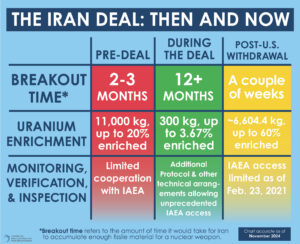Updated May 2024
To understand why the Biden administration has charged American diplomats with reviving the Iran nuclear deal, known formally as the Joint Comprehensive Plan of Action (JCPOA), one only need look at what would happen in its absence. Without it, Iran has moved closer to a nuclear weapon and is threatening to reach a permanent status whereby the global community would remain on high alert, uncertain of when Iran could decide to weaponize.
However, reviving the JCPOA can help prevent this eventuality. There are two paths to accumulate weapons-grade fissile material for a nuclear weapon: enriching uranium-235 to 90% purity or higher and separating plutonium. The JCPOA blocked both paths. In fact, the plutonium-related provisions of the JCPOA were of such merit that the Trump administration issued sanctions waivers for several years, ensuring the United Kingdom and China could continue to modify Iran’s heavy water reactor at Arak without being subject to economic penalties. As originally designed, the Arak reactor could have produced enough plutonium from its spent fuel for one or two nuclear weapons per year, but the JCPOA put that path to bed.
Now, Iran’s advancing uranium enrichment program is the key obstacle for diplomats trying to revive the deal. The JCPOA restricted Iran from enriching uranium past 3.67% until 2030, but today, Iran is enriching uranium to a higher purity and its stockpile is increasing in response to the United States’ withdrawal from the nuclear deal. Iran is also introducing advanced centrifuges and conducting experiments with uranium metal.
As seen from the chart below, Iran’s breakout time—the amount of time it would take for Iran to accumulate enough fissile material for a nuclear weapon, but not including the time it would take to build a weapon—has been substantially decreased from more than one year to about a week. Although somewhat arbitrary, breakout time can give an idea of the level of danger should Iran decide to weaponize. The JCPOA’s real benefit, however, lies in the transparency provided under the verification regime, now lost, that allowed Iran the opportunity to build confidence that it was not producing weapons.


